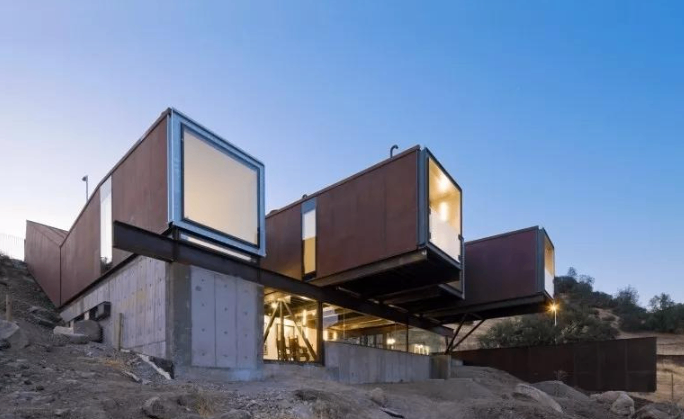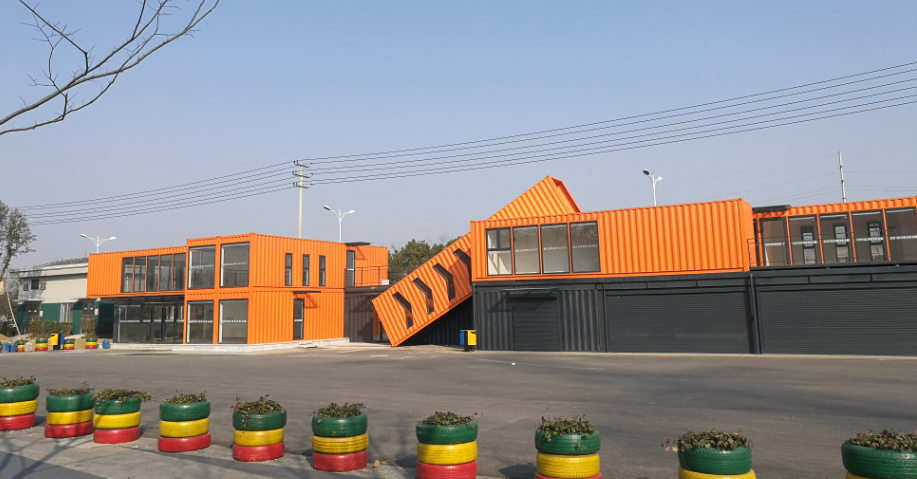
Design requirements for containers
(1) Arrangement of containers
In architecture, several containers are used to create elevated spaces such as balconies, corridors, etc. at different angles and heights. Parallel, offset, diagonal and other planar elements create space. Different lengths can create some outdoor balconies. Angular rotation can create some irregular balconies and sheltered spaces. Misalignment can create balconies in different directions. Misalignment and height changes occur simultaneously, and box combinations may create triangular spaces.
(2) Specific applications of container arrangement
The commonly used centralized vertical spatial relationship in containers varies in length and can create some outdoor balconies; Angular rotation can create irregular balconies and shelter spaces, with staggered relationships that can create balconies in different directions. Flat splicing is a major factor that can determine whether a container building has charm. Whether the space is easy to use and whether the sense of distance is well grasped all come from this. Considering security factors such as theft prevention, the long side of the container itself can also be used as a good bodyguard. Remove the upper structural components, convert the lower components into rotatable ones, and restore the container to its original state when it is closed. During the day, open it to the ground to expose the indoor scene. At the same time, the external container board can also land to form a small entrance square and space for people to rest and drink tea in the open air.
(3) Waterproof treatment
1. Construction of waterproofing membrane
After cleaning the base layer, apply adhesive on the back of the roll and the base layer, stick and roll from far to near according to the marked reference line, and finally perform joint closure inspection and treatment. After completion, a water storage experiment should be conducted.
2. Waterproof coating
Taking "one cloth, two coatings" as an example: after cleaning the base layer, apply a full coat of paint, dry and form a film, lay a layer of fiberglass cloth matrix reinforcement material, and fix it with a full coat of paint on the flattened surface. After drying, proceed to the next layer of roof waterproofing construction.
3. Lay a rigid waterproof layer
Construction will be carried out about two days after the completion of the first flexible waterproof layer, mainly using advanced fatty acid mortar waterproofing agent, cement, sand, fine aggregate, and fiber as the basic materials. The thickness of the waterproof layer should be 20-30 millimeters.

(4) Container interior/exterior wall/exterior top treatment
Inside the container: In order to meet the requirements of fire resistance, thermal insulation and other performance limits of not less than 45 minutes for walls and ceilings, glass rock wool sandwich panels with a thickness of not less than 50mm are used for decoration indoors.
Walls/ceilings are generally decorated with European pine board, gypsum board, cement fiber board, polymer assembly board, aluminum alloy carved board, anti-corrosion wood, etc;
Container exterior: The walls are generally covered with exposed graffiti, glass, aluminum panels, anti-corrosion wood, cement fiberboard and other curtain walls,
The top of the container is waterproofed with roll material, and treated with aluminum plates, color steel plates, anti-corrosion wooden terraces, and other top treatments.
In recent years, many new business models have emerged, most of which choose containers as the core element. The commercial units of the creative container commercial district have eighteen different forms of presentation, which can integrate various different scenes and stand out as independent beauty, creating a landscape effect with unique texture. Diversified formats and diverse gameplay, modular elements covering trendy items in containers, vivid color matching, simple and stylish exterior coating, full of freshness. Using containers as carriers and the perspective of mobile commerce, we break through the boundaries of scene possibilities and beautiful landscapes, and accompany tourists and consumers to discover more interesting spaces, creating a unique experience of "living elsewhere". According to the functions and requirements of the business format, mobile shops with containers as unit modules can be combined in various styles, assembled conveniently, and can be used immediately upon landing, realizing multiple business possibilities. By utilizing the planning and combination of container commercial units, a semi open "street view town" can be quickly constructed, transforming previously visible blocks or squares into interesting spaces worth exploring. Urban culture and avant-garde trends allow tourists to experience them on their own during the exploration process.
